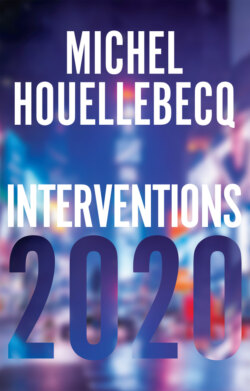Читать книгу Interventions 2020 - Мишель Уэльбек - Страница 16
4 Staring into the distance: in praise of silent cinema
ОглавлениеHuman beings speak; sometimes they don’t speak. When they are threatened, they contract, their gaze darts around in search of something; in despair, they withdraw, curl up into a centre of anguish. When they are happy, their breathing slows down; they exist at a more spacious rhythm. In the history of the world there have been two arts (painting, sculpture) that have attempted to synthesize human experience by means of frozen representations – of arrested movements. They have sometimes chosen to arrest the movement at its most gentle point of equilibrium (at its point of eternity): all those Virgins with Child. They have sometimes chosen to freeze the action at its point of greatest tension, its most intense expressiveness – as in the Baroque, of course; but so many of Caspar David Friedrich’s paintings also evoke a frozen explosion. They have developed over several millennia; they have also sometimes been able to produce works that are finished, in the sense of their most secret ambition: that of stopping time.
In the history of the world there has been one art whose object was the study of movement. This art was able to develop over a period of about thirty years. Between 1925 and 1930 it produced a few shots, in a few films (I am thinking especially of Murnau, Eisenstein, Dreyer) which justified its existence as art; then it was gone, apparently forever.
Jackdaws emit signs of alert and mutual recognition; up to sixty of these signs have been listed. Jackdaws remain an exception: taken as a whole, the world operates in terrible silence; it expresses its essence through form and movement. The wind blows through the grass (Eisenstein); a tear trickles down a face (Dreyer). Silent cinema saw an immense space open before it: it was not just an investigation of human feelings; not just a survey of the movements of the world; its deepest ambition was to constitute an inquiry into the conditions of perception. The distinction between figure and ground constitutes the basis of our representations; but also, more mysteriously, between figure and movement, between form and its process of generation, our mind seeks its way in the world – hence this almost hypnotic sensation that overwhelms us when we are faced by a fixed form generated by a perpetual movement, like the stationary ripples on the surface of a pond.
What remained of it after 1930? Some traces, especially in the works of filmmakers who had started to work in the era of the silent film (the death of Kurosawa will be more than the death of a single man); a few moments in experimental films, scientific documentaries, even serial productions (Australia, released a few years ago, is one example). These moments are easy to recognize: all speech is impossible; music itself becomes a bit kitschy, a bit heavy, a bit vulgar. We become pure perception; the world appears, in its immanence. We are very happy, oddly happy. Falling in love can also have this kind of effect.
